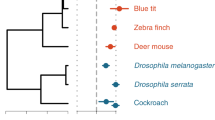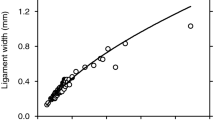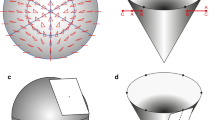Abstract
Parameters in the two-parameter allometric equation are commonly estimated by fitting a straight line to logarithmic transformations of the original data and by back-transforming the resulting model to the arithmetic scale. However, log transformation distorts the relationship between the predictor and response variables, and this distortion may be sufficient to lead unsuspecting investigators to analyze data that actually are unsuited for allometric research. Two data sets from the current literature are re-examined here to illustrate instances in which log transformation caused ugly data to look deceptively good. One of the investigations focused on the scaling of metabolism to body mass in evolutionary transitions from prokaryotic to protistan to metazoan levels of organization whereas the other addressed the scaling of intestines to body size in rodents. In both instances investigators were led to conclusions that are not supported by the original data. Problems of the sort described here can readily be avoided simply by performing preliminary graphical analysis of observations expressed in the original units and by validating the final model in the arithmetic domain.


Similar content being viewed by others
References
Anscombe FJ (1973) Graphs in statistical analysis. Am Stat 27:17–21
Bales GS (1996) Heterochrony in brontothere horn evolution: allometric interpretations and the effect of life history scaling. Paleobiology 22:481–495
Bartlett MS (1947) The use of transformations. Biometrics 3:39–52
Behrens JT (1997) Principles and procedures of exploratory data analysis. Psychol Methods 2:131–160
Brown JH, West GB, Enquist BJ (2000) Scaling in biology: patterns and processes, causes and consequences. In: Brown JH, West GB (eds) Scaling in biology. Oxford University Press, Oxford, pp 1–24
Calder WA III (1984) Size, function, and life history. Harvard University Press, Cambridge
Caruso T, Garlaschelli D, Bargagli R, Convey P (2010) Testing metabolic scaling theory using intraspecific allometries in Antarctic microarthropods. Oikos 119:935–945
Cook RD, Weisberg S (1980) Characterizations of an empirical influence function for detecting influential cases in regression. Technometrics 22:495–508
Cox NJ, Warburton J, Armstrong A, Holliday VJ (2008) Fitting concentration and load rating curves with generalized linear models. Earth Surf Proc Landf 33:25–39
DeLong JP, Okie JG, Moses ME, Sibly RM, Brown JH (2010) Shifts in metabolic scaling, production, and efficiency across major evolutionary transitions of life. Proc Natl Acad Sci USA 107:12941–12945
Emerson JD, Stoto MA (1983) Transforming data. In: Hoaglin DC, Mosteller F, Tukey JW (eds) Understanding robust and exploratory data analysis. Wiley, New York, pp 97–128
Finney DJ (1989) Was this in your statistics textbook? V. Transformation of data. Exp Agric 25:165–175
Gillooly JF, Brown JH, West GB, Savage VM, Charnov EL (2001) Effects of size and temperature on metabolic rate. Science 293:2248–2251
Glass NR (1969) Discussion of calculation of power function with special reference to respiratory metabolism in fish. J Fish Res Board Can 26:2643–2650
Gould SJ (1966) Allometry and size in ontogeny and phylogeny. Biol Rev 41:587–640
Hartwig F, Dearing BE (1979) Exploratory data analysis. Sage Publications, Beverly Hills
Hayes JP, Shonkwiler JS (2006) Allometry, antilog transformations, and the perils of prediction on the original scale. Physiol Biochem Zool 79:665–674
Hoyle MH (1973) Transformations—an introduction and a bibliography. Int Stat Rev 41:203–223
Jacoby WG (1997) Statistical graphics for univariate and bivariate data. Sage Publications, Thousand Oaks
Kerkhoff AJ, Enquist BJ (2009) Multiplicative by nature: why logarithmic transformation is necessary in allometry. J Theor Biol 257:519–521
LaBarbera M (1989) Analyzing body size as a factor in ecology and evolution. Annu Rev Ecol Syst 20:97–117
Lane PW (2002) Generalized linear models in soil science. Eur J Soil Sci 53:241–251
Lovegrove BG (2010) The allometry of rodent intestines. J Comp Physiol B 180:741–755
Makarieva AM, Gorshkov VG, Li B-L (2005) Energetics of the smallest: do bacteria breathe at the same rate as whales? Proc R Soc B 272:2219–2224
Makarieva AM, Gorshkov VG, Li B-L, Chown SL, Reich PB, Gavrilov VM (2008) Mean mass-specific metabolic rates are strikingly similar across life’s major domains: evidence for life’s metabolic optimum. Proc Natl Acad Sci USA 105:16994–16999
Osborne JW (2002) Notes on the use of data transformations. Pract Assess Res Eval 8(6) (http://PAREonline.net/getvn.asp?v=8&n=6)
Osborne JW, Overbay A (2004) The power of outliers (and why researchers should ALWAYS check for them). Pract Assess Res Eval 9(6) (http://PAREonline.net/getvn.asp?v=9&n=6)
Packard GC (2009) On the use of logarithmic transformations in allometric research. J Theor Biol 257:515–518
Packard GC, Boardman TJ (2008) Model selection and logarithmic transformation in allometric analysis. Physiol Biochem Zool 81:496–507
Packard GC, Boardman TJ (2009a) A comparison of methods for fitting allometric equations to field metabolic rates of animals. J Comp Physiol B 179:175–182
Packard GC, Boardman TJ (2009b) Bias in interspecific allometry: examples from morphological scaling in varanid lizards. Biol J Linn Soc 96:296–305
Packard GC, Birchard GF, Boardman TJ (2011) Fitting statistical models in bivariate allometry. Biol Rev (in press)
Peters RH (1983) The ecological implications of body size. Cambridge University Press, Cambridge
Sartori AF, Ball AD (2009) Morphology and postlarval development of the ligament of Thracia phaseolina (Bivalvia: Thraciidae), with a discussion of model choice in allometric studies. J Mollusc Stud 75:295–304
Schmidt-Nielsen K (1984) Scaling/why is animal size so important?. Cambridge University Press, Cambridge
Smith RJ (1984) Allometric scaling in comparative biology: problems of concept and method. Am J Physiol 246:R152–R160
Smith RJ (1993) Logarithmic transformation bias in allometry. Am J Phys Anthropol 90:215–228
Snee RD (1977) Validation of regression models: methods and examples. Technometrics 19:415–428
Strauss RE (1993) The study of allometry since Huxley. In: Huxley JS (ed) Problems of relative growth, new edition. Johns Hopkins Press, Baltimore, pp xlvii–lxxv
Tukey JW (1957) On the comparative anatomy of transformations. Ann Math Stat 28:602–632
Tukey JW (1972) Data analysis, computation and mathematics. Q Appl Math 30:51–65
Tukey JW (1977) Exploratory data analysis. Addison-Wesley, Reading
Verwijst T (1991) Logarithmic transformations in biomass estimation procedures: violation of the linearity assumption in regression analysis. Biomass Bioenergy 1:175–180
Warton DI, Wright IJ, Falster DS, Westoby M (2006) Bivariate line-fitting methods for allometry. Biol Rev 81:259–291
White CR (2011) Allometric estimation of metabolic rates in animals. Comp Biochem Physiol A 158:346–357
Zuur AF, Ieno EN, Elphick CS (2010) A protocol for data exploration to avoid common statistical problems. Meth Ecol Evol 1:3–14
Acknowledgments
I thank the authors whose work is re-examined here for presenting their data in sufficient detail that they could be studied from a different perspective and with the aid of different procedures. I am grateful, also, to Ian Hume and two referees for their very helpful and constructive criticisms of the manuscript.
Author information
Authors and Affiliations
Corresponding author
Additional information
Communicated by I.D. Hume.
Appendix
Appendix
Values for metabolism and mass of inactive (a) and active (b) protistans were taken from Table S1 in DeLong et al. (2010) and transformed to common logarithms. The linear model fitted by ordinary least squares (OLS) to 52 observations for inactive species is \( \widehat{{{ \log }\,Y }} = - 3. 1 2 2 + 0. 9 30\,{ \log }\,X \) whereas that fitted to 51 observations for active species is \( \widehat{{{ \log }\,Y }} = - 2. 5 3 3 + 0. 90 3 {\text{ log}}\,X \). Equations fitted to the same observations by reduced major axis regression (RMA) are \( \widehat{{{ \log }\,Y }} = - 2. 8 3 4 + 0. 9 6 6 {\text{ log}}\,X \) and \( \widehat{{{ \log }\,Y }} = - 1. 30 1 + 1.0 8 3 {\text{ log}}\,X \) for inactive and active protistans, respectively. Untransformed values for metabolism and mass of inactive (c) and active (d) protistans are displayed in bivariate plots with linear scales. The lines are based on equations obtained by back-transforming models fitted to logarithms. The OLS line for inactive protistans is an acceptable fit, but that for active organisms is not. Neither of the RMA regressions is a good fit. Observations for metabolism of inactive (e) and active (f) protistans are shown with corresponding masses expressed on logarithmic axes to provide better visual separation of data for small species. Although the models estimated by back-transformation are good fits to observations for the smallest species, all these observations effectively comprise single points when displayed on graphs with linear scales (c, d)
Values for metabolism and mass of inactive (a) and active (b) metazoans were taken from Table S1 in DeLong et al. (2010) and transformed to common logarithms. The linear model fitted by ordinary least squares (OLS) to 15 observations for inactive species is \( \widehat{{{ \log }Y }} = - 3. 4 5 2 + 0. 7 3 7\, {\text{ log}}X \) whereas that fitted to 71 observations for active species is \( \widehat{{{ \log }Y }} = - 3.0 7 9 + 0. 7 1 4 \,{\text{ log}}X \). Equations fitted to the same observations by reduced major axis regression (RMA) are \( \widehat{{{ \log }Y }} = - 3. 4 4 8 + 0. 7 6 2\, {\text{ log}}X \) and \( \widehat{{{ \log }Y }} = - 2. 9 2 2 + 0. 7 8 8\, {\text{ log}}X \) for inactive and active metazoans, respectively. Untransformed values for metabolism and mass of inactive (c) and active (d) metazoans are displayed in bivariate plots with linear scales. The lines are based on equations obtained by back-transforming models fitted to logarithms. The data set for inactive organisms was dominated by a single outlier. The OLS line arguably is a reasonable fit to data for active animals but the RMA line is not. Observations for metabolism of inactive (e) and active (f) metazoans are shown with corresponding masses expressed on logarithmic axes to provide better visual separation of data for small species. The plot for active animals raises the possibility that the three largest species are outliers
a Common logarithms for body mass and cecum length for 18 species of herbivorous rodent were taken from Table 6 in Lovegrove (2010). A straight line fitted to the transformations by ordinary least squares confirmed the equation reported by the author, namely, \( \widehat{{{ \log }Y }} = 1. 7 6 1 + 0. 1 5 6 \,{\text{ log}}X \). A line fitted by generalized linear modeling has the equation \( \widehat{{{ \log }Y }} = 1. 80 7 + 0. 1 4 5\, {\text{ log}}X \). Note how slopes for the fitted lines were influenced by observations for the mole rat Bathyergus and the marmot Marmota. b Equations estimated by back-transformation are displayed against the back-drop of observations expressed in the original units. Neither of the tracings is a good fit to observations spanning the full range in body size
Rights and permissions
About this article
Cite this article
Packard, G.C. Unanticipated consequences of logarithmic transformation in bivariate allometry. J Comp Physiol B 181, 841–849 (2011). https://doi.org/10.1007/s00360-011-0565-3
Received:
Revised:
Accepted:
Published:
Issue Date:
DOI: https://doi.org/10.1007/s00360-011-0565-3







